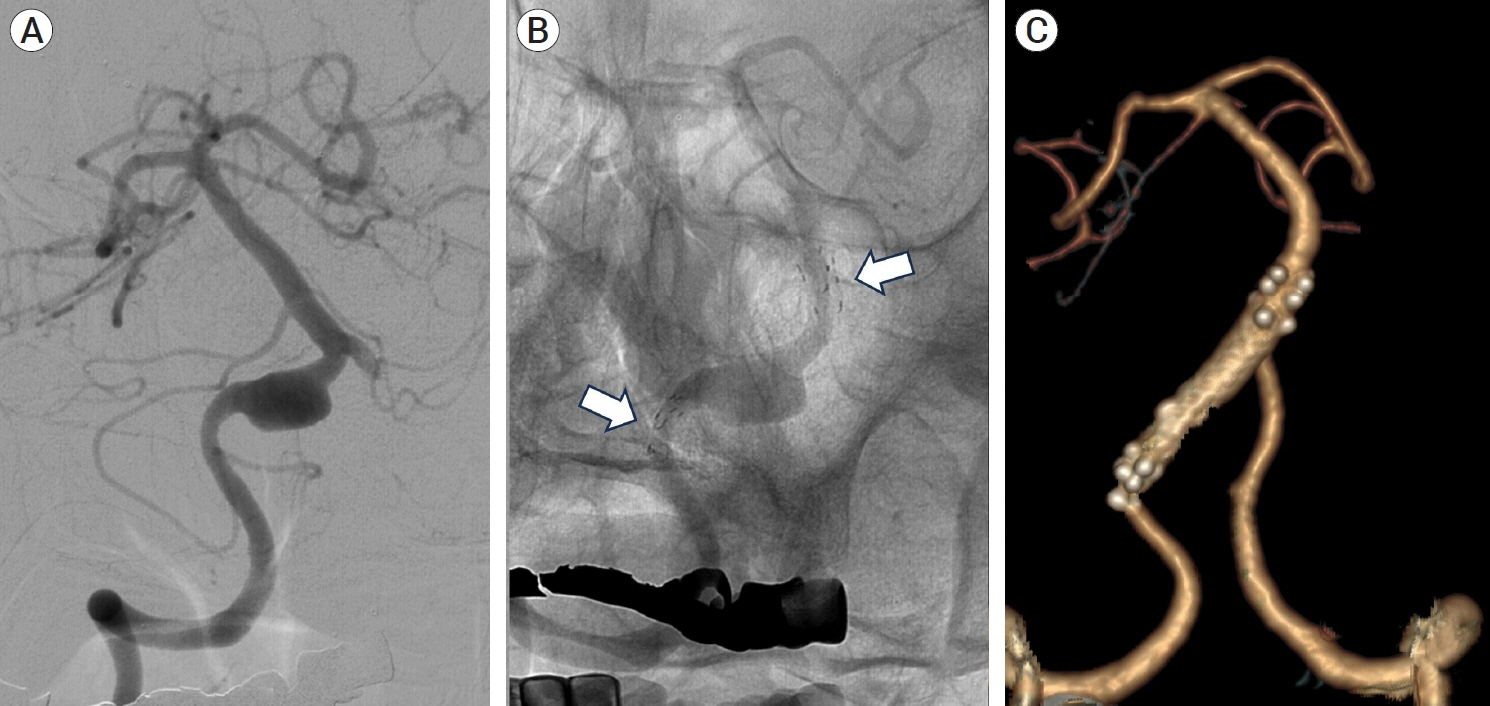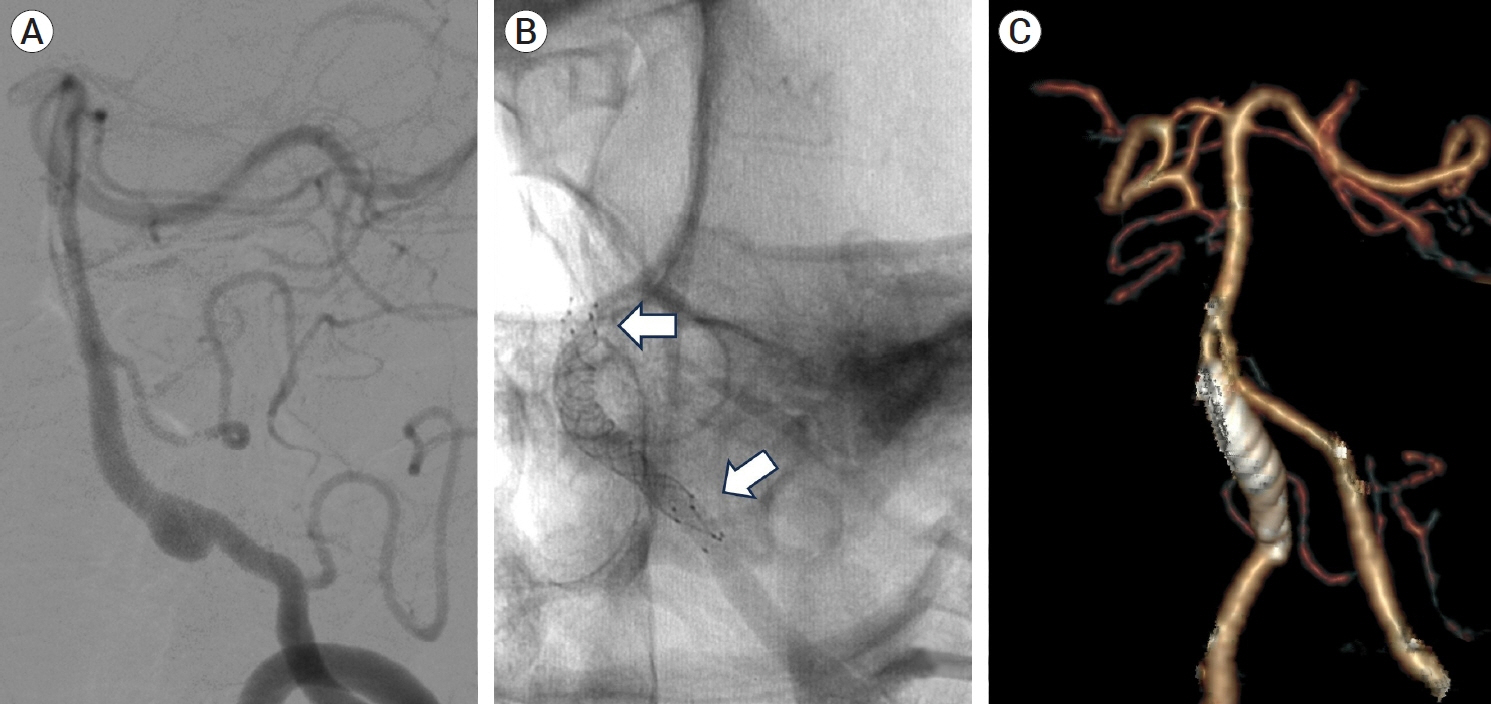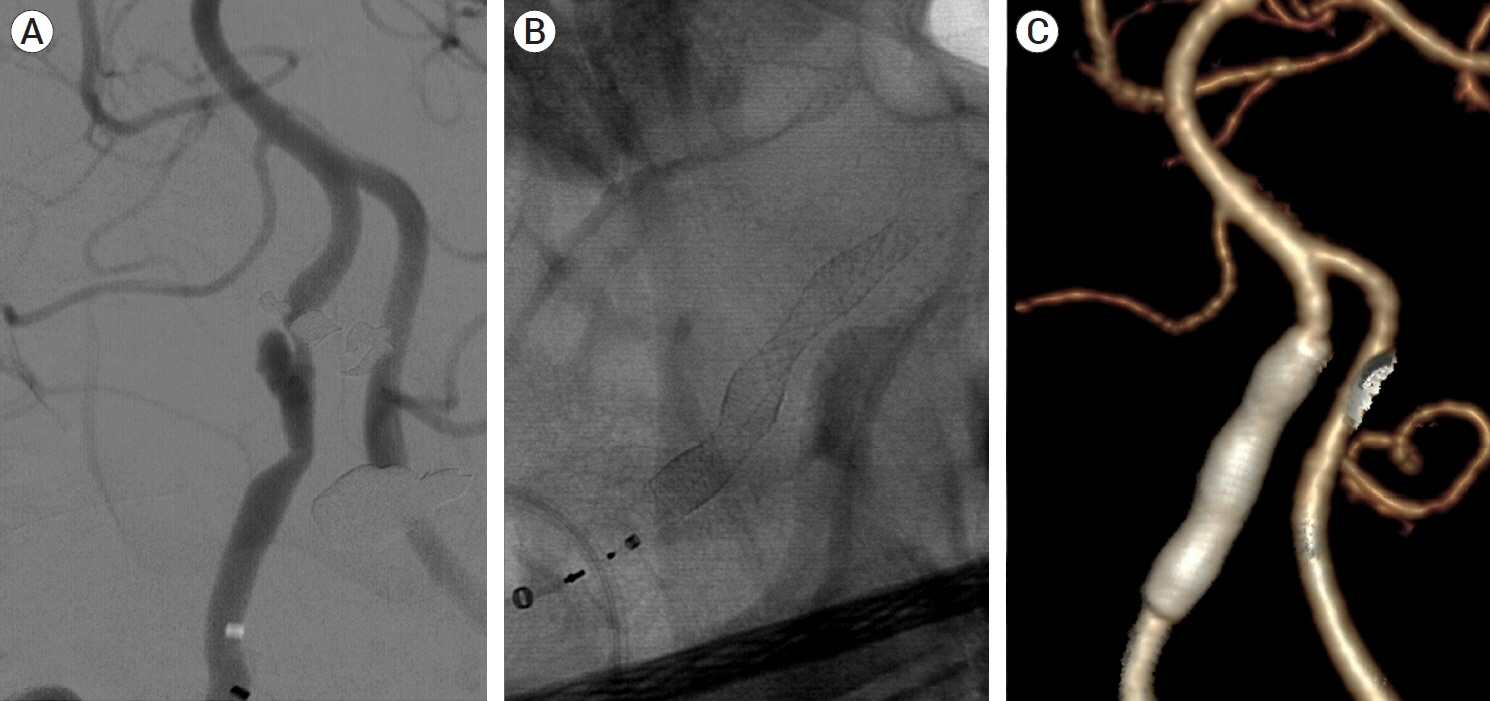J Cerebrovasc Endovasc Neurosurg.
2024 Sep;26(3):284-292. 10.7461/jcen.2024.E2024.02.006.
Multiple telescopic stenting versus single flow diverter for the treatment of vertebral artery dissecting aneurysm
- Affiliations
-
- 1Department of Neurosurgery, School of Medicine, Kyungpook National University, Daegu, Korea
- 2Department of Radiology, School of Medicine, Kyungpook National University, Daegu, Korea
- KMID: 2559438
- DOI: http://doi.org/10.7461/jcen.2024.E2024.02.006
Abstract
Objective
Reconstruction methods, including stent-assisted coiling, multiple telescopic stents, and flow diverters, are preferred modalities for the treatment of unruptured vertebral artery dissecting aneurysms (VADAs). We aimed to compare the clinical outcomes between two reconstructive flow diversion techniques: single flow diverter (FD) device and multiple telescopic stenting (TS).
Methods
We retrospectively reviewed the clinical data of 39 patients with unruptured VADAs. Of these, 17 patients were treated with multiple TS and 22 with a single FD device. Aneurysm characteristics and clinical outcomes were compared between the two groups.
Results
All aneurysms included in this study successfully achieved flow diversion, regardless of the treatment modality and duration. However, the mean procedure duration to complete the diversion was shorter in the FD group. Subgroup analysis in TS group showed that there were no significant clinical differences between the low-profile visualized intraluminal support and Enterprise stents, except for the mean procedure duration.
Conclusions
Both the single FD and multiple TS methods showed excellent angiographic and clinical outcomes in the treatment of unruptured VADAs. However, single FD required a shorter procedure duration and was associated with faster achievement of complete flow diversion.
Figure
Reference
-
1. Ahn JY, Han IB, Kim TG, Yoon PH, Lee YJ, Lee BH, et al. Endovascular treatment of intracranial vertebral artery dissections with stent placement or stent-assisted coiling. AJNR Am J Neuroradiol. 2006; Aug. 27(7):1514–20.2. Ahn SS, Kim BM, Suh SH, Kim DJ, Kim DI, Shin YS, et al. Spontaneous symptomatic intracranial vertebrobasilar dissection: Initial and follow-up imaging findings. Radiology. 2012; Jul. 264(1):196–202.
Article3. Brinjikji W, Murad MH, Lanzino G, Cloft HJ, Kallmes DF. Endovascular treatment of intracranial aneurysms with flow diverters: A meta-analysis. Stroke. 2013; Feb. 44(2):442–7.
Article4. Chalouhi N, Tjoumakaris S, Starke RM, Gonzalez LF, Randazzo C, Hasan D, et al. Comparison of flow diversion and coiling in large unruptured intracranial saccular aneurysms. Stroke. 2013; Aug. 44(8):2150–4.5. Cho DY, Kim BS, Choi JH, Park YK, Shin YS. The fate of unruptured intracranial vertebrobasilar dissecting aneurysm with brain stem compression according to different treatment modalities. AJNR Am J Neuroradiol. 2019; Nov. 40(11):1924–31.
Article6. Drake CG, Peerless SJ. Giant fusiform intracranial aneurysms: review of 120 patients treated surgically from 1965 to 1992. J Neurosurg. 1997; Aug. 87(2):141–62.
Article7. Kim CH, Lee CH, Kim YH, Sung SK, Son DW, Lee SW, et al. Flow diverter devices for the treatment of unruptured vertebral artery dissecting aneurysm. J Korean Neurosurg Soc. 2021; Nov. 64(6):891–900.
Article8. Kim S, Yang H, Hong I, Oh JH, Kim YB. Computational study of hemodynamic changes induced by overlapping and compacting of stents and flow diverter in cerebral aneurysms. Front Neurol. 2021; Aug. 12:705841.
Article9. Kurata A, Ohmomo T, Miyasaka Y, Fujii K, Kan S, Kitahara T. Coil embolization for the treatment of ruptured dissecting vertebral aneurysms. AJNR Am J Neuroradiol. 2001; Jan. 22(1):11–8.10. Lee W, Han HJ, Kim J, Park KY, Kim YB, Jang CK, et al. Flow diverter for the treatment of large (>10 mm) vertebral artery dissecting aneurysms. Acta Neurochir. 2022; May. 164(5):1247–54.
Article11. Mizutani T, Aruga T, Kirino T, Miki Y, Saito I, Tsuchida T. Recurrent subarachnoid hemorrhage from untreated ruptured vertebrobasilar dissecting aneurysms. Neurosurgery. 1995; May. 36(5):905–11. discussion 912-3.
Article12. Nakagawa K, Touho H, Morisako T, Osaka Y, Tatsuzawa K, Nakae H, et al. Long-term follow-up study of unruptured vertebral artery dissection: Clinical outcomes and serial angiographic findings. J Neurosurg. 2000; Jul. 93(1):19–25.
Article13. Narata AP, Yilmaz H, Schaller K, Lovblad KO, Pereira VM. Flow-diverting stent for ruptured intracranial dissecting aneurysm of vertebral artery. Neurosurgery. 2012; Apr. 70(4):982–8. discussion 988.
Article14. Oh HS, Bae JW, Hong CE, Kim KM, Yoo DH, Kang HS, et al. Flow diverter in unruptured intracranial vertebral artery dissecting aneurysm. Front Neurol. 2022; Jun. 13:912863.15. Panchendrabose K, Muram S, Mitha AP. Promoting endothelialization of flow-diverting stents: A review. J Neurointerv Surg. 2021; Jan. 13(1):86–90.
Article16. Park KW, Park JS, Hwang SC, Im SB, Shin WH, Kim BT. Vertebral artery dissection: Natural history, clinical features and therapeutic considerations. J Korean Neurosurg Soc. 2008; Sep. 44(3):109–15.
Article17. Sönmez Ö, Brinjikji W, Murad MH, Lanzino G. Deconstructive and reconstructive techniques in treatment of vertebrobasilar dissecting aneurysms: A systematic review and meta-analysis. AJNR Am J Neuroradiol. 2015; Jul. 36(7):1293–8.
Article18. Tan LA, Keigher KM, Munich SA, Moftakhar R, Lopes DK. Thromboembolic complications with pipeline embolization device placement: Impact of procedure time, number of stents and pre-procedure P2Y12 reaction unit (PRU) value. J Neurointerv Surg. 2015; Mar. 7(3):217–21.
Article
- Full Text Links
- Actions
-
Cited
- CITED
-
- Close
- Share
- Similar articles
-
- Flow Diverter Device for Treatment of Cerebral Aneurysm with Short-Term Follow Up: Two Case Reports
- Delayed fatal rupture of vertebral artery after treated with flow-diverter in fibromuscular dysplasia patient: A case report and review of the literature
- Treatment of Ruptured Dissecting Aneurysm Associated with Fenestration of Vertebral Artery: A Case Report
- Two Cases of Intracranial Vertebral Artery Dissecting Aneurysm Improved by Antiplatelets Therapy
- Dissecting Aneurysm of the Intracranial Vertbral Artery: Case Report




